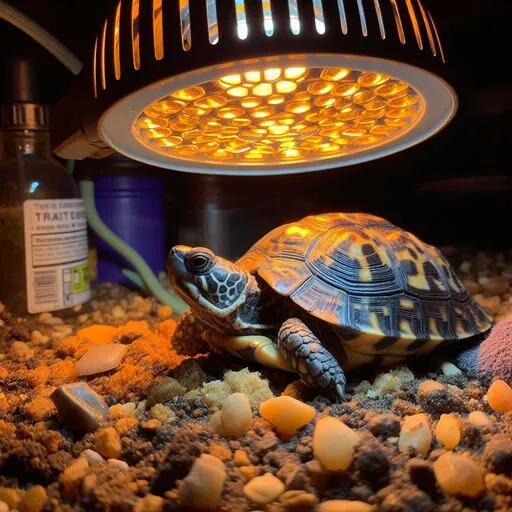Are you considering adopting a box turtle as a pet? If so, you’ve come to the right place!
In this article, we’ll cover everything you need to know about how to take care of a box turtle and ensure they live a happy, healthy life.
Get to Know Box Turtles
What are box turtles?
Box turtles are small, terrestrial reptiles belonging to the family Emydidae.
They are known for their distinctive, high-domed shells that resemble a box when closed.

Why are they popular pets?
Box turtles are popular pets due to their unique appearance, docile nature, and relatively low maintenance requirements.
What are the specific needs of box turtles?
Like any pet, box turtles have specific needs that must be met to ensure their health and happiness.
These include proper enclosure, diet, lighting, heating, handling, and healthcare.
Choosing the Right Box Turtle
Picking Your Perfect Pet
Selecting the perfect box turtle for you involves considering several important factors.
Keep these points in mind when making your choice:

Species: Research various box turtle species, each with unique appearances and care requirements, to find the best match for you.
Age: Decide whether you prefer a younger, more adaptable turtle or an older turtle with established habits and personality.
Health: Inspect potential pets for signs of illness, such as wheezing, eye or nose discharge, or abnormal shell growth, and choose a healthy turtle.
- Personality: Observe the turtle’s behavior, looking for an active, alert, and responsive individual as your future pet.
Enclosure
Creating a Comfortable Home for Your Box Turtle
To create a comfortable home for your box turtle, consider the following factors:
Size: A box turtle’s enclosure should be at least 4 feet long, 2 feet wide, and 2 feet tall.
This allows enough space for them to roam and explore.
Substrate: A mixture of coconut coir, cypress mulch, and sphagnum moss works well for box turtles.

This substrate retains moisture and allows for easy burrowing.
Enclosure features: Your box turtle’s enclosure should include:
- A basking spot with a flat rock or log
- Hiding places, such as half-logs or artificial caves
- A water dish large enough for your turtle to soak in
- Live or artificial plants for decoration and cover
Cleaning: Clean your box turtle’s enclosure at least once a week, removing any waste and replacing the substrate as needed.
Diet
Feeding Your Box Turtle the Right Foods
A balanced diet is essential for a healthy box turtle. Keep these tips in mind when feeding your pet:
What do box turtles eat?
Being omnivores, box turtles consume both plant and animal matter. Their diet should consist of a mix of vegetables, fruits, insects, and protein sources like lean meat.
Feeding frequency: Feed your box turtle every other day, offering a variety of foods to ensure they receive all necessary nutrients.

Good food options: Some excellent choices for your box turtle’s diet include:
- Vegetables: Leafy greens, squash, bell peppers, and carrots
- Fruits: Berries, melons, and apples
- Insects: Earthworms, crickets, and mealworms
- Protein: Lean meat, such as chicken or turkey
Foods to avoid: Steer clear of feeding your box turtle the following:
- High-fat meats, like beef or pork
- Dairy products
- Processed human foods
- Avocado, as it can be toxic to turtles
Lighting and Heating
Providing the Right Environment
Box turtles need proper lighting and heating to maintain good health. Here’s what you need to know:
- Lighting: Box turtles require UVB lighting to help them synthesize vitamin D3, which is crucial for calcium absorption and shell health.
- Use a high-quality UVB bulb and replace it every six months.
- UVB exposure: Your box turtle should be exposed to UVB light for 10-12 hours each day.

- Heating: A heat lamp should be provided to create a basking spot with a temperature of 85-90°F. The cooler end of the enclosure should be around 70-75°F.
- Basking temperature: The ideal basking temperature for box turtles is between 85-90°F.
Handling
Interacting with Your Box Turtle Safely
Handling your box turtle properly is essential for their well-being. Follow these guidelines:

- Safe handling: Always wash your hands before and after handling your box turtle. When picking them up, support their entire body and shell with your hands.
- Handling frequency: Limit handling to once or twice a week to avoid stressing your box turtle.
- Stress signs: If your box turtle exhibits signs of stress, such as hiding, refusing to eat, or excessive hissing, give them some space and limit handling.
Health Care
Keeping Your Box Turtle Healthy
Regular healthcare is vital for your box turtle’s well-being. Keep these tips in mind:
- General health: Monitor your box turtle for any changes in behavior, appetite, or appearance.
- Should you observe anything out of the ordinary, seek advice from a reptile-savvy veterinarian.
- Common health problems: Some health issues that can affect box turtles include respiratory infections, shell rot, parasites, and vitamin deficiencies.

- Vet visits: Schedule annual check-ups with a reptile veterinarian to ensure your box turtle remains in good health.
Box Turtle Behavior
Understanding Your Pet’s Body Language
Understanding your box turtle’s body language can help you identify their needs and emotions.
Keep an eye out for these common behaviors:

- Basking: Box turtles will often bask under their heat lamp to warm up. This behavior is normal and healthy.
- Hiding: Box turtles may hide when they feel threatened or stressed.
- If your turtle is hiding frequently, ensure their enclosure provides enough hiding spots and consider reducing handling.
- Soaking: Box turtles may soak in their water dish to hydrate, regulate their body temperature, or help with shedding.
- Ensure their water dish is always clean and filled with fresh water.
- Digging: Box turtles often dig and burrow in their substrate. This is a natural behavior and helps them feel secure.
Breeding Box Turtles
An Overview
If you’re interested in breeding box turtles, consider the following:
- Sexing: To determine the sex of your box turtle, examine their tail and plastron (the bottom part of their shell).
- Males generally have longer, thicker tails and a slightly concave plastron.
- Mating: Box turtles typically mate in the spring and fall. During courtship, males may circle the female, bob their head, or even nip at her shell.

- Egg-laying: After mating, females will lay eggs in a nest they dig in the substrate. It’s essential to provide a suitable nesting area with slightly moist substrate for egg-laying.
- Incubation: Box turtle eggs require specific temperature and humidity levels for successful incubation.
- Research the requirements for your specific species and set up an incubator accordingly.
- Hatchlings: Once the eggs hatch, provide the hatchlings with a separate enclosure, proper lighting, heating, and a balanced diet to ensure their healthy growth.
Box Turtle Safety
Keeping Your Pet and Home Safe
To ensure the safety of both your box turtle and your home, follow these tips:

- Escape-proofing: Ensure your box turtle’s enclosure is secure and escape-proof to prevent them from getting lost or injured.
- Supervision: When allowing your box turtle to roam outside their enclosure, always supervise them to prevent accidents or injuries.
- Household hazards: Be aware of potential household hazards, such as toxic plants, chemicals, or other pets that could pose a risk to your box turtle.
- Quarantine: If you introduce a new box turtle to your home, quarantine them for a few weeks to ensure they are healthy and prevent the spread of illness to your existing pets.
Conclusion
Keeping the advice in this article in mind, you are on the right path to offering outstanding care for your box turtle.
Don’t forget to keep a close eye on their health, create an appropriate habitat, and supply a nutritious diet to guarantee a long and joyful life for them.
For more information on box turtle care, consult reputable resources, such as books, websites, or local reptile experts.
Additional Tips
Socialization, Enrichment, and Hibernation
- Socialization: Although box turtles are solitary animals, occasional socialization with other box turtles can be beneficial.
- Enrichment: Keep your box turtle mentally and physically stimulated with toys, puzzles, and hiding places.
- Hibernation: Some box turtles hibernate during winter. If your turtle hibernates, provide a suitable hibernation spot and monitor them closely during this time.










